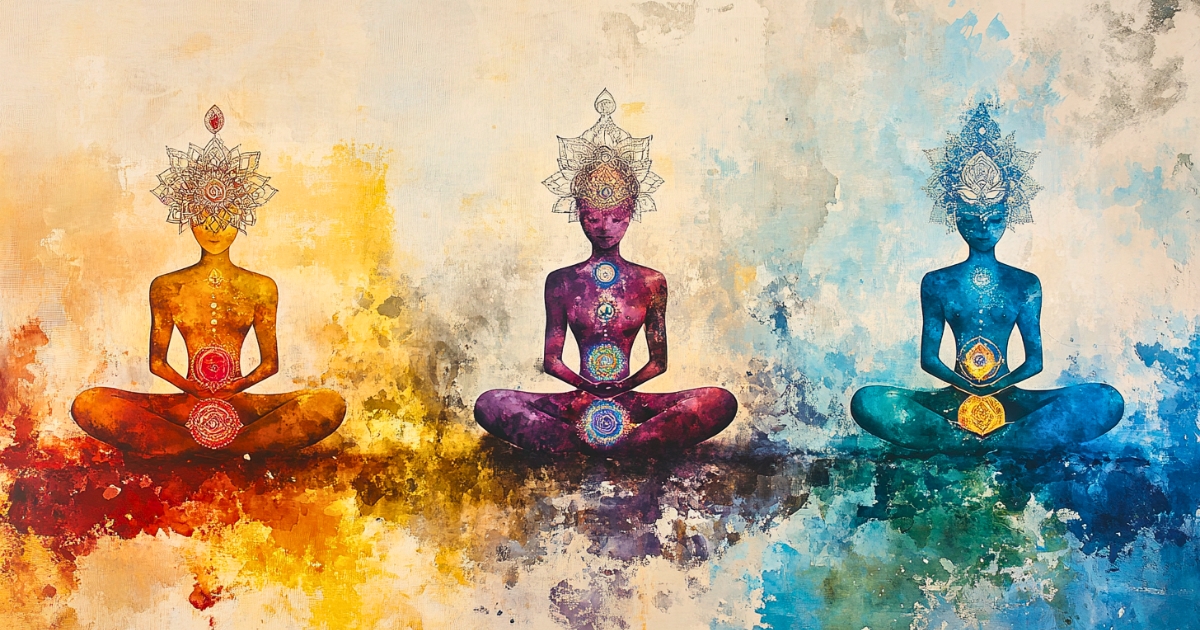Introduction
The chakra system, based on ancient Indian wisdom, is known as the energy centers connecting the human body and mind. Chakra balancing is a practice that promotes physical and mental health and well-being by harmonizing these energy centers. This article will explain in detail the seven main chakras, symptoms when each chakra is imbalanced, and specific methods to restore balance.
The Seven Main Chakras and Their Characteristics
Muladhara (Root Chakra)
Location: Base of the spine
Color: Red
Element: Earth
Function: Safety, stability, basic survival needs
Details: Muladhara is deeply connected to our survival instincts. It governs material stability, physical health, and connections with family and society. When this chakra is activated, one gains confidence and a sense of security, strengthening the foundation of life.
Swadhisthana (Sacral Chakra)
Location: Lower abdomen
Color: Orange
Element: Water
Function: Creativity, emotions, sexual energy
Details: Swadhisthana is associated with joy, passion, and sensory experiences. It promotes artistic expression, sexual intimacy, and emotional flow. When this chakra is balanced, one can fully enjoy life and freely express creative energy.
Manipura (Solar Plexus Chakra)
Location: Solar plexus
Color: Yellow
Element: Fire
Function: Self-esteem, personal power, willpower
Details: Manipura is the center of personal power and self-awareness. It nurtures confidence, self-esteem, and self-discipline. When this chakra is activated, one can take responsibility for their life and actively work towards goals.
Anahata (Heart Chakra)
Location: Center of the chest
Color: Green
Element: Air
Function: Love, compassion, relationships
Details: Anahata is the source of unconditional love and compassion. It nurtures self-love, love for others, and universal love. When this chakra is balanced, one can develop deep empathy and build healthy relationships. It also helps maintain a balance between self-acceptance and acceptance of others.
Vishuddha (Throat Chakra)
Location: Throat
Color: Blue
Element: Ether
Function: Communication, self-expression, truth
Details: Vishuddha is involved in self-expression and the transmission of truth. It governs the power of words, creative expression, and listening skills. When this chakra is open, one can clearly convey their truth and listen to others. It also enhances the ability to receive and express creative inspiration.
Ajna (Third Eye Chakra)
Location: Between the eyebrows
Color: Indigo
Element: Light
Function: Intuition, insight, imagination
Details: Ajna is the center of inner wisdom and insight. It promotes intuition, clear thinking, and spiritual insight. When this chakra is activated, one can see things from a higher perspective and gain deep self-understanding and insight into universal truths. It also enhances creative vision and intuitive abilities.
Sahasrara (Crown Chakra)
Location: Crown of the head
Color: Purple or White
Element: Thought
Function: Spirituality, higher consciousness, connection to the universe
Details: Sahasrara governs spiritual awakening and connection to universal consciousness. It promotes pure awareness, cosmic wisdom, and connection to higher purpose. When this chakra is open, one can recognize greater wholeness and deeply understand the mysteries of life and one’s role in it. It also allows for deeper experiences in meditation and spiritual practices.
Symptoms of Chakra Imbalance
When each chakra is imbalanced, various physical, emotional, and mental symptoms may appear.
- Muladhara: Anxiety, financial insecurity, loneliness, lethargy, chronic fatigue
- Swadhisthana: Lack of creativity, emotional instability, sexual issues, loss of pleasure, addictive tendencies
- Manipura: Lack of confidence, indecisiveness, stress, digestive issues, suppressed anger
- Anahata: Relationship problems, lack of empathy, feelings of isolation, difficulty expressing love, weakened immune system
- Vishuddha: Communication difficulties, suppressed self-expression, throat problems, creative blocks, poor listening skills
- Ajna: Decreased intuition, lack of concentration, headaches, vision problems, indecisiveness
- Sahasrara: Spiritual alienation, loss of sense of purpose, depression, feelings of confinement, disconnection from higher consciousness
Specific Methods for Chakra Balancing
Meditation
Focus on each chakra and visualize its color while regulating your breath. For example, to balance Muladhara, imagine a red light spreading from the base of your spine.
Yoga
Practice specific poses that work on each chakra. For example, the “Cobra Pose” is effective for Anahata.
Color Therapy
Wear colors corresponding to the chakras or consume foods of those colors. For example, wear blue or eat blueberries to balance Vishuddha.
Crystal Healing
Wear or use stones corresponding to each chakra during meditation. For example, amethyst is effective for Ajna.
Affirmations
Recite positive words related to each chakra. For example, use affirmations like “I am confident” for Manipura.
Music Therapy
Listen to musical scales or instrument sounds corresponding to the chakras. For example, high-pitched bells or singing bowls are effective for Sahasrara.
Aromatherapy
Use essential oils related to each chakra. For example, ylang-ylang or jasmine oils are suitable for Swadhisthana.
Easy-to-Implement Chakra Balancing Practices for Daily Life
- Morning Chakra Meditation: Spend 5 minutes after waking up focusing on each chakra and taking deep breaths.
- Color Coordination: Wear the color of the chakra you want to strengthen that day.
- Chakra Affirmation Cards: Create affirmation cards for each chakra, draw one daily, and recite it.
- Chakra Yoga Mini-Routine: Before bed, do one yoga pose corresponding to each chakra.
- Chakra Balancing Tea: Drink herbal teas effective for each chakra, rotating daily.
- Chakra Breathing Technique: When feeling stressed, take deep breaths while focusing on the related chakra.
- Chakra Walking Meditation: While walking, imagine each chakra from the soles of your feet to the crown of your head in order.
Conclusion
Chakra balancing is an effective method for promoting physical and mental health and well-being. By understanding the seven main chakras and balancing each one, you can lead a more harmonious and fulfilling life. By gradually incorporating chakra balancing practices into your daily life, you can improve energy flow and enhance overall health and happiness.
It’s important to use chakra balancing as a complementary approach, not as an alternative to Western medicine. If you have serious health concerns, always consult with a medical professional. Why not try using chakra balancing as a tool to find inner harmony and lead a more fulfilling life?


